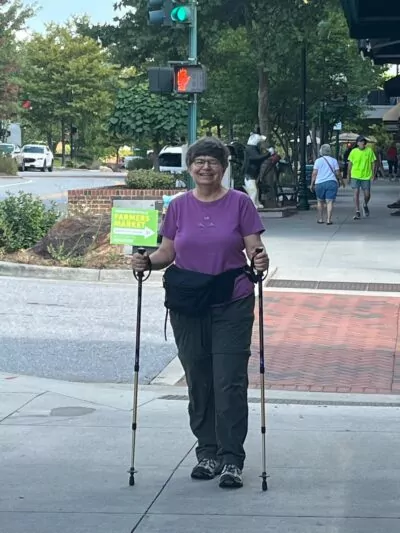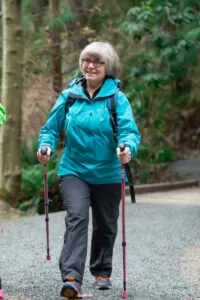
“What Are Those Poles For?”
“Are you practicing your skiing?” a colleague quipped at a conference at the beach. “Did you hike here?” asked the server at a restaurant near my home in the Blue Ridge mountains. “What are those poles for?” wondered the stranger in a park near our daughter’s home in Washington DC.
Those are some of the questions I have been asked in the six years that I’ve used hiking poles on a regular basis to help maintain my balance. I’ve wrestled with how to respond. Technically, they are trekking poles, since they were adapted from cross-country skis for the Nordic sport of trekking. My husband Robert and I have used them for hiking in state and national parks since we first learned about them in 2003.
Thus, we had hiking poles on hand when I was hospitalized with vestibular neuritis in August 2016 and came out reeling. We quickly discovered the added benefits of the poles in navigating — whether walking in the neighborhood, visiting the store, going to church and work, or doing other normal activities. They helped me maintain my balance when all of life felt out of balance.
Soon after I left the hospital, I began vestibular rehab therapy (VRT). After 12 weeks of VRT, I regained my ability to walk in familiar places. I do not need my poles on a daily basis. However, I have developed PPPD (Persistent Postural Perceptual Dizziness). I still struggle to keep my balance in unfamiliar places, especially ones that are noisy, crowded, or have bright or flashing lights. I easily feel lightheaded or dizzy in those situations. So my poles have remained very handy.
 Still, I have not found a straightforward answer to the question “What are those poles for?” Few people understand the response “I have a vestibular disorder.” They either look at me blankly, nod with a look that says “I don’t know what you’re talking about, but I’ll pretend that I do,” or ask “What’s that?”
Still, I have not found a straightforward answer to the question “What are those poles for?” Few people understand the response “I have a vestibular disorder.” They either look at me blankly, nod with a look that says “I don’t know what you’re talking about, but I’ll pretend that I do,” or ask “What’s that?”
To bypass that, I’ll sometimes answer the question by saying “I have issues with my balance.” That often elicits responses like “So do my parents,” “I have a friend who does,” or “I sometimes stumble as I get older.” They often add “Join me for yoga classes. They’ve helped me,” or “Have you tried Stretch and Balance classes?” While those exercises can help, they don’t address the underlying vestibular issue.
I’ve concluded that my best response is “I have a vestibular disorder. It affects my balance.” That names the primary issue — vestibular disorder — while also explaining its effects. Then if they ask further questions, I can explain that maintaining balance is complex. The brain has to combine three kinds of sensory information – proprioception, or the body’s sense of movement and location through our feet, legs and other muscles; vision, to give an additional sense of spatial location; and vestibular information from our inner ear. If one of those is not functioning well, we can lose our balance and become light-headed, dizzy, or fall.
In my case, the vestibular nerve was damaged, most likely by a virus. That’s the nerve that sends messages from the inner ear to the brain. Vestibular rehabilitation therapy helped my brain and vestibular nerve compensate for the harm that had been done. However, if my brain gets overwhelmed by too many stimuli, it has difficulty dealing with all the information it is receiving. I develop brain fog and can become light-headed or dizzy. At that point, the best treatment is to give my brain a chance to rest and recharge by lying down and taking a nap.
Most balance exercises focus on a person’s sense of location and movement and the muscles in their legs and feet and other core muscles. Those exercises do not harm me and can indeed help me maintain my overall balance. However, since they do not deal with my vestibular system, they do not fully address the dizziness I experience.
On the other hand, the hiking poles do help me, because they mean my brain does not have to work so hard to keep me in balance. Therefore, I often use my poles in circumstances that may not require them, such as walking in the neighborhood, in order to conserve my brainpower. With the poles, I can also hike five miles with my husband to view mountain scenery and spectacular waterfalls, navigate a crowded restaurant, attend a concert or play, or visit a museum. Those are all activities that bring me joy and fulfillment.
When I use the hiking poles, I can walk in confidence, without fear of stumbling or falling. That is a small price to pay for the curious looks I get.
By Carol Cannon

 REGain Your Mobility with Activator Poles
REGain Your Mobility with Activator Poles